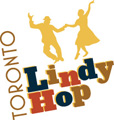
Toronto Lindy Hop
Anyone can do the Lindy Hop, aka swing dance! Join us on the dance floor.
NO PARTNER NEEDED!
Lindy Hop, also known as swing dance, is at its heart a social dance, with each step improvised on-the-fly on the dance floor. It is also a popular competitive and performance dance, with competitions and shows taking place all over the world.
Whether you are new to the dance scene or have been dancing for years, we hope to provide you with information on beginner classes, social events, and more. Please stay tuned as we regroup after COVID-19.
Visit our Events or Classes pages for more info.

Lindy Hop Timeline
???- 1920s – Precursors:
DNA of many different forms of Black dance appear in Lindy Hop. This includes forms of vernacular jazz dance, including tap, partnered Charleston, the cakewalk, and the Texas Tommy (a dance that originated in San Francisco!).
Mid-1920s – Lindy Hop and the “naming” of the dance:
By the mid 1920s, the dance needed a name. A well-known myth states that “Shorty” George Snowden named the dance after seeing a headline about Charles Lindbergh’s transatlantic flight that said “Lindy Hops the Atlantic,” but as the “hop” was already a term used to describe the dance, this is unlikely to be true.
1929 – Lindy Hop appears on film:
The breakaway, a close precursor to Lindy Hop, can be seen in footage from the film After Seben (1929). The dance, at this point, resembles a sort of Lindy Hop/Charleston hybrid.
1930s – The Savoy Ballroom:
The Savoy Ballroom is where up-and-coming dancers, like Frankie Manning, Al Minns, and Norma Miller, would dance to live swing bands with leaders like Chick Webb and Count Basie.
1930s-1940s – Lindy Hop in Hollywood:
Dean Collins made a name for LA-style Lindy Hop, while Whitey’s Lindy Hoppers, a troupe formed at the Savoy, performed in films like A Day at the Races (1937) and Hellzapoppin (1941). The dancers were often filmed apart from the rest of the film, in the event that Southern audiences ask that scenes with the Black dancers be cut.
1940s and onward – Mainstream success and offshoots:
While WWII took famous Lindy Hoppers and musicians to war, white dancers like Arthur Murray developed simplified versions, like the Jive and what we know as East Coast Swing. Meanwhile, Black musicians moved jazz to bebop, and the dance evolved with it.
1980s to today – Resurgence:
A group of curious dancers see Lindy Hop on film, find the folks that used to do it, and humbly ask folks like Frankie Manning and Al Minns to show them how it’s done. International dance scenes and communities form. Meanwhile, Black social dancers continue with hip hop, house dance, line dance, and other forms of social dance.
History of the Lindy Hop
Lindy Hop was danced predominantly by Black dancers starting in the 1920s. Many of them lived in Harlem, New York, where there were dance clubs such as the Savoy and Alhambra ballrooms.
Lindy Hop emerged as a defiant, joyous response to financial hardship caused by the Great Depression, harsh living conditions, and systemic racism.

“I’ve never seen a Lindy Hopper who wasn’t smiling.”
-Frankie Manning-
Join us on the dance floor.
Lindy Hop Classes
Interested in learning how to Lindy Hop? Head on over to our Swing Dance Classes page to see what we have to offer. No partner is needed!
Please note, due to COVID-19, there is only one place in Toronto offering lessons. But please sign up for our newsletter to stay informed about future events!
Social Dances
Come dancing with us! Social swing dances are a great way to meet people, dance and listen to live swing music or amazing DJs, and have a fun time out.
Due to the pandemic, our social dance scene has changed. Please be safe if you are attending any events, and click below for current information.
Special Events
Toronto Lindy Hop organizes and hosts several special events throughout the year. To receive notifications for upcoming TLH events, follow us on Facebook or check out our Facebook events page.
We host fun events like our Lindy Hop Workshop, Lindyworks and our cottage weekender, Lindystock! CLICK HERE!








